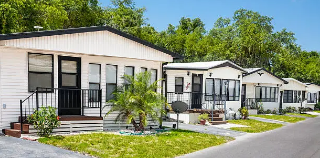Prefab homes, short for prefabricated homes, are a game-changing innovation in the housing industry, offering a blend of efficiency, affordability, and modern design. Unlike traditional homes built on-site, prefab homes are constructed in a factory setting and then transported to their final location for assembly. This construction method is not only faster but also offers superior quality control and a reduction in waste. As housing demands continue to rise and environmental concerns become more pressing, prefab homes are emerging as a sustainable and practical solution. This article explores the history, types, benefits, challenges, and future prospects of prefab homes, illustrating why they are an increasingly popular choice for homeowners and developers alike.
A Brief History of Prefab Homes
The concept of prefabrication in construction has a long history, dating back centuries. One of the earliest examples can be found in the 1600s when English settlers in America used prefabricated components to build homes in the New World. However, the modern prefab home movement began in the early 20th century, driven by technological advancements and the need for affordable housing solutions.
During the post-World War II era, there was a significant housing shortage in many countries. Prefab homes provided a quick and cost-effective solution to this problem. For instance, the United States saw a surge in the popularity of prefabricated houses, with companies like Lustron Corporation producing steel-framed homes that were assembled on-site. These homes were designed to meet the needs of returning soldiers and their families, offering a practical and economical housing option.
In the latter half of the 20th century, the prefab housing market evolved, incorporating new materials and design philosophies. The introduction of modular construction, where entire sections of a home are built in a factory and then assembled on-site, marked a significant advancement. This period also saw the rise of mobile homes and manufactured housing, which further expanded the scope of prefabricated living solutions.
Types of Prefab Homes
Prefab homes come in various forms, each with unique characteristics and construction methods. The three main types of prefab homes are modular homes, panelized homes, and manufactured homes.
- Modular Homes: These homes are constructed in sections, or modules, in a factory setting. Each module is built to precise specifications and includes all necessary components, such as walls, flooring, and ceilings. Once completed, the modules are transported to the home site and assembled on a pre-built foundation. Modular homes are highly customizable and can range from simple single-story designs to elaborate multi-story structures. They must adhere to the same local building codes and regulations as site-built homes, ensuring they meet high standards of quality and safety.
- Panelized Homes: Unlike modular homes, which are built in modules, panelized homes are constructed using flat panels, such as walls and roofs, that are assembled on-site. The panels are manufactured in a factory and include pre-installed insulation, wiring, and other features. Once delivered to the site, these panels are put together to form the structure of the home. Panelized construction offers greater flexibility in design and allows for more complex architectural features. It also reduces construction time and labor costs compared to traditional building methods.
- Manufactured Homes: Often referred to as mobile homes, manufactured homes are built entirely in a factory and transported to their final location as a complete unit. These homes are constructed on a permanent chassis, allowing them to be moved if necessary. Manufactured homes must comply with the federal building code set by the U.S. Department of Housing and Urban Development (HUD) rather than local building codes. They offer an affordable housing option and are commonly found in designated communities or mobile home parks.
Benefits of Prefab Homes
Prefab homes offer numerous advantages, making them an attractive option for a wide range of homeowners. Some of the key benefits include:
- Cost Efficiency: One of the most significant advantages of prefab homes is their cost-effectiveness. Factory construction allows for bulk purchasing of materials and reduces labor costs, resulting in lower overall expenses. Additionally, the streamlined construction process minimizes delays and unexpected costs, making budgeting more predictable.
- Faster Construction: Prefab homes can be built much faster than traditional site-built homes. Since much of the construction occurs in a controlled factory environment, weather delays and other disruptions are minimized. Once the prefab components are ready, they can be assembled on-site in a matter of days or weeks, depending on the complexity of the design.
- Quality Control: The controlled environment of a factory allows for strict quality control measures, ensuring that each component of the home meets high standards. This level of oversight reduces the likelihood of defects and construction errors, resulting in a durable and well-built final product.
- Sustainability: Prefab homes are often more environmentally friendly than traditional homes. The factory construction process generates less waste, as materials are used more efficiently and excess can be recycled. Additionally, prefab homes can be designed with energy-efficient features, such as high-quality insulation, energy-efficient windows, and solar panels, further reducing their environmental impact.
- Customization and Flexibility: Modern prefab homes offer a high degree of customization, allowing homeowners to choose from various layouts, finishes, and features. Whether someone desires a minimalist tiny home or a spacious multi-story house, prefab construction can accommodate a wide range of preferences and needs.
- Durability and Safety: Prefab homes are built to withstand transportation and assembly, often making them more durable than site-built homes. They must also comply with strict building codes and standards, ensuring they are safe and secure for occupants.
Challenges and Considerations
While prefab homes offer numerous benefits, they are not without challenges. Some of the key considerations include:
- Zoning and Building Regulations: One of the most significant challenges for prefab homes is navigating zoning laws and building regulations. Local governments may have restrictions on where prefab homes can be placed, particularly in areas with strict aesthetic or building standards. It’s essential for potential buyers to research and understand the regulations in their desired location.
- Financing and Insurance: Securing financing and insurance for prefab homes can sometimes be more complicated than for traditional homes. While modular and panelized homes are often treated similarly to site-built homes, manufactured homes may be classified as personal property rather than real estate. This distinction can affect loan terms and availability. Additionally, insurance premiums may vary based on the type of prefab home and its location.
- Perception and Stigma: Despite the advancements in design and construction quality, prefab homes can still carry a stigma as being inferior to traditional homes. This perception can impact resale value and marketability, although it is changing as more high-quality prefab homes are built and recognized for their benefits.
- Transportation and Site Preparation: Transporting large modules or panels to the home site can be logistically challenging, particularly in remote or hard-to-reach areas. Additionally, site preparation, such as laying a foundation and connecting utilities, must be completed before the prefab components can be assembled. These factors can add to the overall cost and complexity of the project.
Future Prospects of Prefab Homes
The future of prefab homes looks promising, driven by increasing demand for affordable, sustainable, and efficient housing solutions. Technological advancements in construction methods, materials, and design software are continually improving the quality and customization options for prefab homes. As the construction industry embraces digital tools and automation, the production process will become even more efficient, reducing costs and construction times further.
The growing awareness of environmental sustainability is also likely to boost the popularity of prefab homes. As more homeowners seek eco-friendly living options, the prefab industry is well-positioned to provide energy-efficient, low-impact housing solutions. The use of renewable materials and energy-efficient technologies will continue to evolve, making prefab homes an even more attractive option for environmentally conscious buyers.
Moreover, the increasing acceptance and recognition of prefab homes as a viable and desirable housing option will help overcome existing stigmas. As more high-profile architects and designers enter the prefab market, the variety and sophistication of available designs will expand, appealing to a broader audience.
Conclusion
Prefab homes represent a significant shift in the housing industry, offering a practical and innovative solution to modern housing challenges. With their cost efficiency, speed of construction, quality control, and sustainability, prefab homes provide an appealing alternative to traditional site-built homes. While there are challenges to consider, the benefits and future potential of prefab homes make them a compelling choice for many prospective homeowners.
As the world grapples with issues such as housing shortages, affordability, and environmental sustainability, prefab homes offer a path forward. They provide a way to build quickly and efficiently, with a focus on quality and environmental responsibility. Whether for urban, suburban, or rural settings, prefab homes are poised to play a critical role in the future of housing, offering a versatile and sustainable option for a wide range of needs and preferences.







